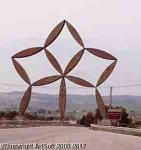Pietro Consagra
Pietro Consagra
Born: 1920
Death: 2005
Biography:
Pietro Consagra was born on the 4th of October 1920 in Mazara del Vallo, Sicily.Son of Luigi and Maria Lentini, Consagra was one of Italy’s most prominent Post-War abstract sculptors: he surpassed the three-dimensionality of the media, encouraging the spectators to have a more immediate approach with the artwork as it was presented as a flatter surface.
Consagra, at first, joined the military – aiming to reach the role of captain. Nevertheless, his innate talent for drawing led him to attend evening art classes and to join a carpentry studio, where he first started to work with clay.Eventually, he moved to Palermo where he undertook Fine Art studies in 1938 at the Accademia di Belle Arti and successfully graduated in 1944.
In the same year as his graduation, his need to be closer to art and to feel in “the beating heart of creativity” led him to move to Rome where he shared a studio with the artist Renato Guttuso. His visit to Paris in the winter of 1946 introduced him to the ateliers of Brancusi, Giacometti, Laurens, Hartung, Adam – who kept many of Picasso’s chalk works – and Pevsner’s home. Such exposure to a great range of artworks and different styles furtherly cemented Consagra’s desire to create something new.
In 1947, Consagra co-founded the art group Forma I at the National Gallery of Prague, organised by the Fronte Nazionale per la Gioventù (Italian Front for the Youth) in 1947. In the following year, the group organised the first non-figurative, abstract art exhibition in post-war Rome, called “Mostra del Gruppo Forma I” (Exhibition of the group Form I) at the Art Club. Later, in the bulletin of the Art Club, Consagra was acclaimed as the only one who, among his colleagues, reached an integrally abstract expression. In 1949 Consagra exhibited at the “Mostra di Scultura Contemporanea” in the gardens of Palazzo Venier dei Leoni (Peggy Guggenheim Foundation) in Venice, where Peggy Guggenheim made her first acquisition of one of Consagra’s artworks for her collection.Henceforth, Consagra exhibited in the Biannale of Venice eleven more times between 1950 and 1993, where he won the sculpture prize at the exhibition in 1960.
In 1952, while being part of the group, Consagra wrote an essay titled “Necessità della Scultura”, (“The Necessity of Sculpture”) in which he defended the practice from the accusations of it being a ‘dead’ art expressed in “La Scultura Lingua Morta” (1945) by Arturo Martini. Consagra felt the need to free the sculpture of its three-dimensional quality, which, according to him, implied an authoritarian approach to the practice. The forced historically-ridden legacy of sculpture pushed Consagra to find a new concept that would allow a more instantaneous communication with the spectator. As he followed that line of thoughts, Consagra started meditating on the different dimensions sculpture can have.
It’s with his series “Colloqui” (“Colloquy”) that Consagra finally introduced the sculptures with a single point of view; starting from 1952, the artist exhibited them at the 1954 and 1956 Venice Biennales – their newly found, and almost provoking, abstraction created a new relationship with the spectator.Larger commissions and the consistent gathering of an international audience, motivated Consagra to seek exposure outside the borders of Italy; he took part of the 1955 Biennale of São Paulo, where he was awarded with the Price “Metalurgica Matarazzo”. In the 1960s Consagra was associated with the group Continuità (1961 – ca. 1970), which saw some members from Forma I: Carla Accardi, Piero Dorazio, and Gastone Novelli – the artists stirred a stronger sense of closeness with Italian art history, referencing its past order and structure.
Throughout his life, he was given several solo exhibitions, such as at the Palais des Beaux-Arts, Brussels (1958), Galerie de France, Paris (1959); Museum Boijmans van Beuningen, and in Rotterdam, Netherlands (1967). In August of the same year, Consagra moved to the United States and taught for a year at the School of Arts in Minneapolis; he later was invited to partake to the exhibition “Sculpture from Twenty Countries” at the Solomon Guggenheim Museum in New York. Later in October, Consagra had a solo exhibition in New York, in which he presented the “Ferri Trasparenti”, “Colloquio col Vento” (“Colloquy with the Wind, 1962), “Giardini”, and the “Piani Appesi”, which featured rotating flat sculptures that followed a spiral, which introduced the concept of ‘bifrontality’ and the experience of the artwork from ‘inwards’ to ‘outwards’ – in the words of the artist: “ With the spiral I move from the inside towards the outside, and from the outside I seek to return inside again: to me this is like breathing”.
More...
Wikipedia link: Click Here






